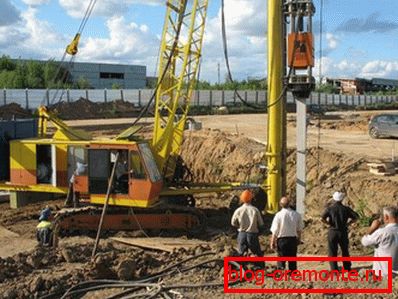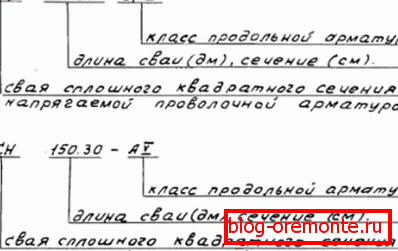Reinforced concrete piles: types and purpose
GOST 19804 - 91 on reinforced concrete piles is a fundamental document that regulates the manufacturing technology, quality control and the use of similar products. Despite the fact that this standard was adopted a long time ago, it has not lost its relevance to this day. That is why it is necessary to familiarize with it to anyone who plans to engage in the construction of foundations of pile type.

Main varieties
Product typology
First, let's look at what is a pile. As a rule, this is a concrete product of class B20 - B30, equipped with a frame made of steel reinforcement. The dimensions of reinforced concrete piles can be different, but most often used products with a cross section of 30x30 or 40x40 cm.

Note! The maximum length of factory-made parts is 12 m. Longer structures make it complex by incorporating steel mortgages into the material, which allow a welded joint. To shorten unnecessarily long supports, reinforced concrete is cut with diamond circles.
Depending on the type of construction, such varieties are distinguished:
| Type of pile | Technological features |
| Zabivny | Solid concrete constructions with solid reinforcement. The penetration is carried out using pile hammers or vibratory pile drivers. The weight of reinforced concrete piles of the driving type is maximum due to its high density. |
| Impressed | Virtually no constructive differences from driven piles with the exception of the cavity inside the rod. Impact loads are worse, because they are immersed using special installations. |
| Shell | They are tubular structures with a clearly defined internal cavity. Most often, the soil from the central part is removed after immersion. |
| Screw | Can be made both from metal, and from reinforced concrete. The most common combination of structures that combine a concrete rod and a steel screw cap. |
| Stuffed and injected | They are produced directly at the facility by filling the hole drilled in the ground with concrete with prior or subsequent amylation. |
Note! When installing the foundation on screw concrete piles, it is necessary either to pre-design metal mortgages, or to use diamond drilling of holes in concrete for fastening the grillage.

Prestressed structures
The so-called reinforced concrete prestressed piles should be singled out as a separate group. They are structures that more effectively resist tensile loads.
This is achieved through the use of a special method of production:
- High-strength steel is used for reinforcement.
- The reinforcement cage is pre-stretched using special mechanisms or electro-thermally processed to create tension.
- In the stretched state, the reinforcement plunges into concrete.
- After polymerization, the structure self-compresses due to the elasticity of the frame, which makes it possible to compensate for the operational loads.

It should be noted that the usual supports can be made with their own hands, but the prestressed piles are made exclusively in the factory. The price of products is also rather big, therefore they are used only where it is impossible to do with usual reinforced concrete.
Production of reinforced concrete piles of any type is accompanied by quality control.
Usually subjected to verification:
- The linear dimensions of the product, as well as the positioning of the reinforcement in the body of the pile.
- Mechanical characteristics, such as the ability to resist compressive and tensile loads.
- Frost resistance.
- Moisture resistance of concrete.
Thanks to such a multi-stage verification, the reject rate for factory products is relatively low.
Product Marking
When you choose reinforced concrete piles - technical characteristics play a very important role. And pick up the material for your needs will help analysis of product labeling.
Typically, a part is indicated by an alphanumeric code, in which:
- A letter or group of letters is a type of pile (we will tell about them below).
- The first number is the pile length in decimeters.
- The second number is the length of the cross section in centimeters.
- The third number is the reinforcement ratio (from 1 to 13).
If we talk about the types of products, the most common are the following:
- C - square solid solid and composite products.
- SP - square with a round internal cavity.
- SC - round with an internal cavity.
- WITH - shell (most often large diameter).

Thus, having understood the marking, we will be able to understand that the C 120.40-6 product is a square driving support, 12 m long, section of 40x40 cm, reinforced in the sixth class.
Use in various conditions
The effectiveness of the use of such products largely depends on how closely the regulatory recommendations are followed.
In general terms, the instruction contains such requirements:
- Solid and composite reinforced concrete driving piles are used to form the foundations for buildings and structures on sandy, loamy, alluvial and biogenic soils.. In this case, either coarse or sandy-silt substrates (not silt) should be located under the base.
- Reinforced concrete piles should consist of two parts.. The joint of the parts is done in such a way that it most effectively transfers the loads that occur during deepening.
Note! When you need to install a longer support, use other types of structures.

- Hollow round and shell models are applied on weak substrates of great depth.. It is also allowed to use shell structures as single supports under columns and other similar elements.
- In the most difficult soil conditions (frozen soils, quicksands), bored and buroin injection technologies are most often implemented..

Conclusion
ГОСТ на железобетонные сваи регулирует практически все аспекты изготовления и применения данных изделий. Изучив данный документ, вы сможете свободно ориентироваться в достаточно обширной номенклатуре, что существенно облегчит вам работу по проектировке и строительству любого здания на свайном фундаменте (см.также статью «Баня из керамзитобетонных блоков: особенности постройки и причины для выбора стройматериала»).
If you are interested in this topic, and you want more information, we recommend watching the video in this article.